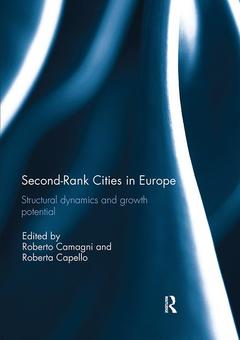Second Rank Cities in Europe Structural Dynamics and Growth Potential
Coordonnateurs : Camagni Roberto, Capello Roberta

Second-rank cities are back on the academic scene, capturing the interest of scholars with their unexpected recent performance with respect to first-rank cities. Looking at the data on average urban GDP growth in 139 European cities since 1996, the relatively strong position of large cities (over 1.5 million inhabitants) on national growth coincides with the periods of fastest expansion, while at times of slowdown second-rank cities prevail. Especially in the recent period of economic downturn, second-rank cities have recorded annual GDP growth rates much less negative than those of capital cities; and in some European countries, like Austria and Germany, all cities have outperformed their capitals.
In explaining this phenomenon, linking urban dynamics to agglomeration theories seems the most interesting approach. However, merely to link agglomeration economies to urban size in order to interpret urban performance is neither convincing nor sufficient, and it calls for additional investigation into how agglomeration economies work. This volume claims that interpretation of the current dynamics in European urban systems ? especially in the western part of Europe ? would benefit from exploitation of the traditional concept of agglomeration economies. However, necessary for this purpose are more in-depth considerations on the nature, scope, intensity, and causes of agglomeration economies which do not relate their existence solely to urban size. And this is where the main challenge for scholars lies, in the interpretation of the missing link between agglomeration economies and urban dynamics. This book was originally published as a special issue of European Planning Studies.
Introduction: Second-Rank City Dynamics: Theoretical Interpretations Behind Their Growth Potentials 1. City Size and Economic Performance: Is Bigger Better, Small More Beautiful or Middling Marvellous?2. The Rise of Second-Rank Cities: What Role for Agglomeration Economies?3. Borrowed Size, Agglomeration Shadows and Cultural Amenities in North-West Europe4. Related Variety and Regional Economic Growth in a Cross-Section of European Urban Regions5. Assessing Polycentric Urban Systems in the OECD: Country, Regional and Metropolitan Perspectives6. First- and Second-Tier Cities in Regional Agglomeration Models7. Polycentric Metropolitan Development: From Structural Assessment to Processual Dimensions
Roberto Camagni is Professor of Urban Economics at the Politecnico di Milano, Italy. He is a Past-President of the European Regional Science Association, and of GREMI . He is the author of many scientific papers, and a textbook in Urban Economics, published in Italian, French, and Spanish.
Roberta Capello is a Professor in Regional Economics at the Politecnico di Milano, Italy. She is a Past-President of the Regional Science Association International . She is the editor in chief of Papers in Regional Science, and of the Italian Journal of Regional Science. She is the author of many scientific papers, and the editor of Territorial Patterns of Innovation: An Inquiry on the Knowledge Economy in European Regions (Routledge, 2013).
Date de parution : 06-2017
17.4x24.6 cm
Disponible chez l'éditeur (délai d'approvisionnement : 14 jours).
Prix indicatif 58,78 €
Ajouter au panierDate de parution : 10-2015
17.4x24.6 cm
Disponible chez l'éditeur (délai d'approvisionnement : 14 jours).
Prix indicatif 172,36 €
Ajouter au panierThème de Second Rank Cities in Europe :
Mots-clés :
Borrowed Size; Agglomeration Shadows; metropolitan development; Agglomeration Economies; polycentric urban systems; Corine Land Cover; agglomeration shadow; Urban Rank; regional growth; Gdp Growth; place-based development; Polycentric Development; economic growth; Polycentric Urban; European Planning Studies; Urban Size; Polycentric Structure; urban systems; Rank Size Distribution; agglomeration theories; Urban Functions; urban dynamics; National Accessibility; urban growth; High Urban Rank; urban expansion; National Economic Performance; European cities; Metropolization Process; Unrelated Variety; second rank cities; Local Population Size; Total Gdp; Polycentric Spatial Structure; City Regional Integration; Ia Lla; European City Regions; Polycentric Urban Structures; Optimal City Size
